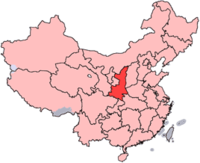
Qinqiang
Encyclopedia

Pinyin
Pinyin is the official system to transcribe Chinese characters into the Roman alphabet in China, Malaysia, Singapore and Taiwan. It is also often used to teach Mandarin Chinese and spell Chinese names in foreign publications and used as an input method to enter Chinese characters into...
: Luàntán) is the representative folk Chinese opera
Chinese opera
Chinese opera is a popular form of drama and musical theatre in China with roots going back as far as the third century CE...
of the northwest Province of Shaanxi
Shaanxi
' is a province in the central part of Mainland China, and it includes portions of the Loess Plateau on the middle reaches of the Yellow River in addition to the Qinling Mountains across the southern part of this province...
, China, where it was called Qin
Qin
-Chinese dynasties and states:*Qin , a state of China during the Eastern Zhou Dynasty*Qin Dynasty , which followed Qin's unification of China in 221 BC and ended in 206 BC*Da Qin , Roman Empire, 202 BC to AD 220...
thousands of years ago. Its melodies were originated from the rural areas of ancient Shaanxi and Gansu
Gansu
' is a province located in the northwest of the People's Republic of China.It lies between the Tibetan and Huangtu plateaus, and borders Mongolia, Inner Mongolia, and Ningxia to the north, Xinjiang and Qinghai to the west, Sichuan to the south, and Shaanxi to the east...
. The word itself means "the tune or sound of Qin".
The genre uses the bangzi (woodblock) as one of the accompanying instruments, from which it derives its other name, Bangzi opera. Bangzi tune is the oldest, most affluent opera tune in China's Four Great Characteristic Melodies
Four Great Characteristic Melodies
Four Great Characteristic Melodies in Chinese opera are Bangziqiang, Huangpiqiang, Kunqiang and Gaoqiang.-Bangziqiang:Qinqiang, Yuju, Jinju, Hebei Bangzi, Sixianqiang in Dianju, Tanxi in Chuanju, etc.-Huangpiqiang:...
. Qinqiang is the representative of the Bangzi opera and the most important origin of other Bangzi operas.
Tan Dun
Tan Dun
Tan Dun is a Chinese contemporary classical composer, most widely known for his scores for the movies Crouching Tiger, Hidden Dragon and Hero.-Early life in China:...
, the composer for the opera The First Emperor
The First Emperor
The First Emperor is an opera in two acts with a libretto written in English by Tan Dun and Ha Jin, and music by Tan Dun. The opera received its premiere at the Metropolitan Opera at the Lincoln Center in New York City on 21 December 2006, conducted by the composer and with Plácido Domingo in the...
, researched Qinqiang for the opera, in order to learn more about "ancient Chinese vocal styles".
History
Qinqiang was banned from "being performed in Beijing" in 1785 by the emperor at the time, QianlongQianlong Emperor
The Qianlong Emperor was the sixth emperor of the Manchu-led Qing Dynasty, and the fourth Qing emperor to rule over China proper. The fourth son of the Yongzheng Emperor, he reigned officially from 11 October 1735 to 8 February 1796...
. It was stated that "the sexual suggestiveness of the genre" was the reason for it being banned, but it is believed that the real reason was because the difference in style from prior Chinese folk opera styles allowed social critique
Social criticism
The term social criticism locates the reasons for malicious conditions of the society in flawed social structures. People adhering to a social critics aim at practical solutions by specific measures, often consensual reform but sometimes also by powerful revolution.- European roots :Religious...
of China to be written into them. The ban, however, only ended up expanding the style into more areas outside of Beijing, primarily to theatres in the southeast.
Characters
There are 13 kinds of characters in Qinqiang including four kinds of "Sheng" (生, male)(老生、須生、小生、幼生), six kinds of "DanDan (Chinese opera)
Dan is the general name for female roles in Chinese opera, often referring to leading roles. There are a few different kinds of dan in Chinese opera. The commonly seen ones are 'Guimen Dan', 'Hua Dan', 'Daoma Dan', 'Wu Dan', 'Lao Dan' and 'Cai Dan'...
" (旦, female)(老旦、正旦、小旦、花旦、武旦、媒旦), two kinds of "Jing" (淨, painted face male)(大淨、毛淨) and one kind of "Chou" (丑, Clown), also knowns as " 13 Tou Wangzi" (十三頭網子).

